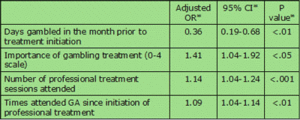Last week, The WAGER discussed differences between two groups of gamblers presenting for treatment: gamblers with and without substances abuse treatment histories. Ladd and Petry (2003) found greater severity of gambling, substance use and psychological problems among patients with a history of substance abuse treatment. Using similar methodology, Petry (2003) investigated the impact of another aspect of treatment history: previous involvement with Gamblers Anonymous (GA). This week’s WAGER examines the relationship between GA attendance, the extent of gambling problems at treatment presentation, and treatment outcomes.
Petry’s study of GA attendance was conducted using the same sample and methodology as the study of substance abuse history (see WAGER 8(44) for methodological details). The study sample consisted of 342 gamblers who were either entering a state-funded gambling treatment program or a cognitive-behavioral treatment study. In addition, the present study drew information from questions specifically addressing GA attendance. Two months after the start of treatment, investigators interviewed participants in the cognitive-behavioral group about GA attendance and current gambling behaviors. Participants in the state treatment program provided the same information through mailed surveys.
At treatment admission, the majority (58%) of gamblers reported having attended at least one GA meeting. Compared to gamblers without GA experience, gamblers with a history of GA attendance
(1) had higher South Oaks Gambling Screen (SOGS) scores (F(1,316)=15.54, p<.001), (2) had a longer duration of gambling problems (F(1,316)=4.21, p<.05), (3) spent fewer days gambling during the month before treatment admission (F(1,316)=21.74, p<.001), (4) were more engaged in the treatment
process (X2(3)=10.98, p<.05), 3), (5) had a greater likelihood of attending GA concurrent with professional treatment (X2(3)=37.83, p<.001), and (6) were more likely to be abstinent two months into treatment (X2(2)=8.03, p<.05).
Petry employed stepwise logistic regression to evaluate the relative contribution of various factors on gambling abstinence; Table 1 presents the significant predictors of abstinence in the order they entered the prediction equation and includes days gambled in the month prior to treatment initiation, the importance participants placed on treatment, the number of professional treatment sessions attended and the number of GA sessions attended since professional treatment initiation. Because previous and current GA attendance are highly correlated and share the same predictive power, the model includes only current attendance.
Table 1. Predictors of gambling abstinence 2 months after initiation of professional treatment (from Petry, 2003).
* definitions for OR, CI, and P-value can be found in the glossary.
This study demonstrated an association between GA attendance and abstinence at two months after treatment initiation. Important value to these suggestive results could be added by using a longer follow-up. Ideal follow-up time frames for the treatment of addiction should be similar to follow-up times for the treatment of other chronic disorders (e.g., five years for cancer). In addition, the cause of the observed short-term benefits can not be definitively determined. One possibility is that GA attendance itself encourages treatment engagement and abstinence. Alternatively, previous GA attendance might be an indication of readiness to change and have no causal influence on abstinence. In addition, this study did not consider past involvement in professional gambling treatment, which might be correlated with GA. Past treatment, readiness to change, or another confounder, might underlie the differences in short-term abstinence.
At treatment entry, an intake history can provide valuable insights into a gambler’s profile and therefore can be used for treatment planning. Similar to a history of substance abuse, a history of GA attendance is associated with an increased severity of gambling problems at treatment presentation. The impact of previous GA attendance on treatment outcomes is less clear; though current GA attendance is predictive of abstinence even after controlling for days gambled pretreatment, importance placed on treatment and number of treatment sessions attended. Longitudinal research is needed to tease out this relationship and enable the clinical community to formulate recommendations regarding GA.
Comments on this article can be addressed to Rachel Kidman.
References
Ladd, G. T., & Petry, N. M. (2003). A Comparison of Pathological Gamblers With and Without Substance Abuse Treatment Histories. Experimental & Clinical Psychopharmacology, 11(3), 202-209.
Petry, N. M. (2003). Patterns and correlates of Gamblers Anonymous attendance in pathological gamblers seeking professional treatment. Addictive Behaviors, 28, 1049-1062.





